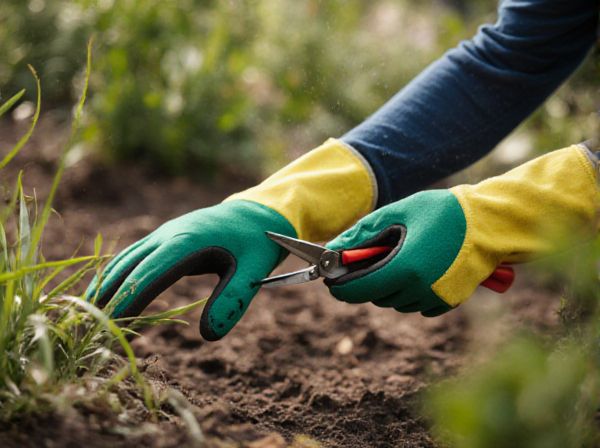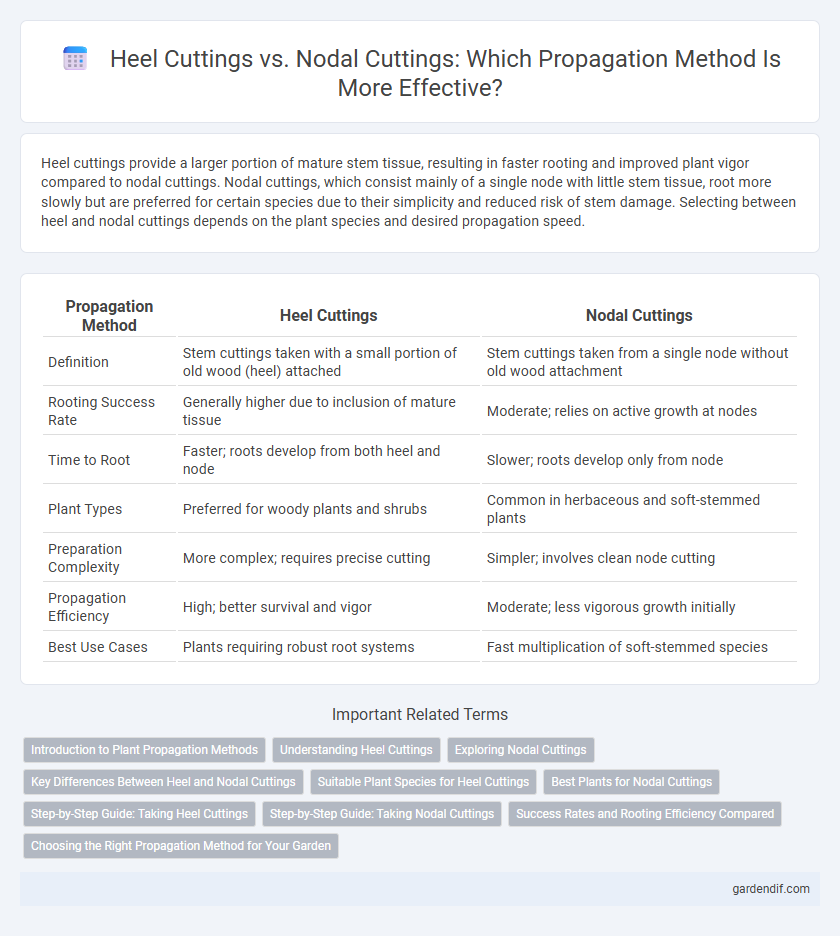
Heel cuttings vs Nodal cuttings Illustration
Heel cuttings provide a larger portion of mature stem tissue, resulting in faster rooting and improved plant vigor compared to nodal cuttings. Nodal cuttings, which consist mainly of a single node with little stem tissue, root more slowly but are preferred for certain species due to their simplicity and reduced risk of stem damage. Selecting between heel and nodal cuttings depends on the plant species and desired propagation speed.
Table of Comparison
| Propagation Method | Heel Cuttings | Nodal Cuttings |
|---|---|---|
| Definition | Stem cuttings taken with a small portion of old wood (heel) attached | Stem cuttings taken from a single node without old wood attachment |
| Rooting Success Rate | Generally higher due to inclusion of mature tissue | Moderate; relies on active growth at nodes |
| Time to Root | Faster; roots develop from both heel and node | Slower; roots develop only from node |
| Plant Types | Preferred for woody plants and shrubs | Common in herbaceous and soft-stemmed plants |
| Preparation Complexity | More complex; requires precise cutting | Simpler; involves clean node cutting |
| Propagation Efficiency | High; better survival and vigor | Moderate; less vigorous growth initially |
| Best Use Cases | Plants requiring robust root systems | Fast multiplication of soft-stemmed species |
Introduction to Plant Propagation Methods
Heel cuttings involve removing a piece of stem with a small portion of older wood attached, promoting quicker root formation compared to nodal cuttings that use only stem segments containing nodes. Nodal cuttings rely on the presence of nodes where adventitious roots and shoots can develop, making them suitable for plants with strong node activity. Both methods serve as essential plant propagation techniques for cloning, with heel cuttings often favored for woody species due to improved rooting success.
Understanding Heel Cuttings
Heel cuttings involve removing a stem segment with a portion of older, lignified tissue at the base, improving rooting success by providing mature cells that promote root initiation. This method enhances nutrient storage and hormonal balance compared to nodal cuttings, which include only the younger, green stems around nodes. Understanding the physiological advantages of heel cuttings is crucial for optimizing propagation efficiency in woody plants.
Exploring Nodal Cuttings
Nodal cuttings involve using segments of the stem containing a node, which houses dormant buds essential for new shoot development, resulting in higher rooting success compared to heel cuttings. These cuttings typically exhibit faster establishment due to the presence of active meristematic tissue at the nodes, enhancing nutrient transport and root initiation. Nodal cuttings are especially effective for propagating woody plants and vines, offering improved uniformity and vigor in the propagated clones.
Key Differences Between Heel and Nodal Cuttings
Heel cuttings include a small portion of the main stem attached below the node, enhancing root formation by retaining nutrient-rich mature tissue, whereas nodal cuttings consist solely of the stem segment containing the node, relying mainly on the node's inherent ability to produce roots. Heel cuttings often have higher rooting success rates and faster root development due to the presence of mature tissue and stored carbohydrates. Nodal cuttings are simpler and quicker to prepare but may require more precise environmental conditions for successful propagation.
Suitable Plant Species for Heel Cuttings
Heel cuttings are especially suitable for woody plants such as roses, camellias, and azaleas where a portion of older stem tissue helps improve rooting success. These cuttings are advantageous for species that produce difficult-to-root hardwood cuttings, as the retained heel tissue contains callus cells that aid root initiation. In contrast, nodal cuttings work best for herbaceous plants and those with active nodes that readily develop roots without the need for heel tissue.
Best Plants for Nodal Cuttings
Nodal cuttings are ideal for propagating plants like hibiscus, jasmine, and pothos due to their high success rate in rooting and growth uniformity. These cuttings contain a node with meristematic tissue that promotes faster root development compared to heel cuttings. Plants with flexible stems and prominent nodes, such as coleus and basil, respond best to nodal cutting propagation methods.
Step-by-Step Guide: Taking Heel Cuttings
Taking heel cuttings involves selecting a healthy shoot and cutting it just below a node, including a small strip of the stem's base known as the heel. Prepare the cutting by removing lower leaves and slightly wounding the heel to enhance root formation. Insert the heel cutting into a well-draining propagation medium, maintain consistent moisture, and provide indirect light to encourage successful rooting.
Step-by-Step Guide: Taking Nodal Cuttings
Select healthy stem segments with visible nodes for nodal cuttings, ensuring each cutting has at least one node and a length of 4-6 inches. Remove leaves from the lower half, dip the cut end in rooting hormone to encourage root development, then insert the cutting into a moist, well-draining propagation medium such as a mix of perlite and peat moss. Maintain high humidity and indirect light, keeping the medium consistently moist until roots form, typically within 2-4 weeks.
Success Rates and Rooting Efficiency Compared
Heel cuttings generally exhibit higher success rates and rooting efficiency compared to nodal cuttings due to the presence of a small portion of older stem tissue that promotes quicker root initiation. Nodal cuttings, while easier to obtain, often have lower rooting percentages and slower root development because they lack this critical heel tissue. Studies indicate heel cuttings can achieve rooting success rates above 80%, whereas nodal cuttings typically range between 50-70%, making heel cuttings preferable for rapid and reliable propagation.
Choosing the Right Propagation Method for Your Garden
Heel cuttings, which include a small portion of older wood, root faster and are ideal for woody plants requiring strong initial support, while nodal cuttings, taken from sections with nodes, suit herbaceous plants and promote quicker new growth. Selecting the right propagation method depends on plant type, growth habit, and desired propagation speed to maximize success rates. Matching cutting type to the plant's biology ensures healthier root systems and vigorous garden development.
Heel cuttings vs Nodal cuttings Infographic

 gardendif.com
gardendif.com